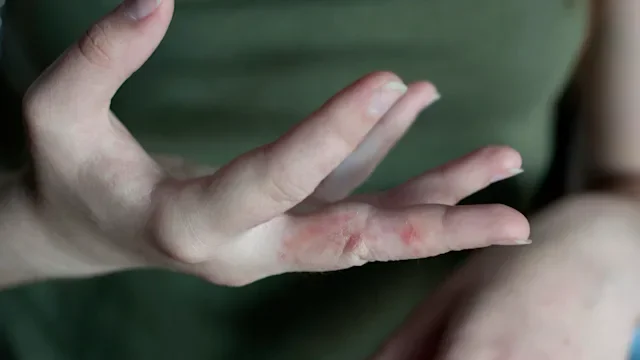Key takeaways:
Topical steroid withdrawal (TSW) is a rare condition that can develop after you stop using a topical corticosteroid (steroid) medication.
The best treatment for TSW is different for everyone. And if you do develop TSW, there’s no specific timeline for how long your symptoms may last.
If you’re using a topical steroid medication, speak with a healthcare professional about how to safely stop using it. They may recommend slowly stopping it over time, especially if you’ve been using it consistently for a while.
Save on related medications
People often turn to corticosteroid (steroid) creams or ointments to treat rashes and skin conditions like eczema. Sometimes, though, stopping a topical steroid suddenly can cause an uncomfortable rash.
Topical steroid withdrawal (TSW) can happen when you stop applying a steroid that your skin has grown accustomed to. This can result in a cluster of painful symptoms. In some cases, the skin becomes so sensitive that it’s hard to move around comfortably.
This reaction to topical steroids isn’t common. But it’s an unwelcome experience when it happens. Below, we’ll discuss TSW and its causes. We’ll also discuss treatment options and how to prevent it in the future.
Search and compare options
What are topical steroids?
Topical steroids are medications that treat many skin conditions. They’re often used to relieve minor skin ailments, such as mild, itchy rashes. They can also treat chronic skin conditions, such as eczema, contact dermatitis, and psoriasis. They lower the redness, swelling, and pain from these conditions.
Topical steroids are most often used for about 1 to 2 weeks at a time. But, in some cases, you might use them for longer periods of time — especially if you have a chronic skin condition. A healthcare professional can tell you how long to use a topical steroid.
What topical steroid medications are commonly available?
Several topical steroids are available in different potencies (strengths). Some are available over the counter (OTC), and others require a prescription.
These are some common examples:
OTC:
Hydrocortisone 0.5% and 1%
Know before you apply: GoodRx pharmacists discuss the key things you should know about topical corticosteroids.
The hidden side effect: Read on to discover medications that can cause skin damage and speed up skin aging.
From stress to soothing: A real person shares their story of how they managed their eczema flare-up.
Prescription-only (from lowest to highest potency):
Topical steroids also come in various forms, such as:
Creams
Lotions
Ointments
Gels
Mousses
Read more like this
Explore these related articles, suggested for readers like you.
What is topical steroid withdrawal (TSW)?
TSW is a reaction that can happen after you stop using a topical steroid medication. It can also happen if you switch from one steroid medication to another.
Over time, your skin can learn to depend on a topical steroid. When you stop using it, your skin can become irritated. This is because your skin no longer has access to the medication. These reactions can happen days or weeks after you stop applying a topical steroid to your skin.
Thankfully, TSW rarely occurs. Using a topical steroid for a short time, or on occasion, usually doesn’t cause issues. It’s more likely to happen if you’ve used a topical steroid consistently for a few months or longer and if you use higher-strength steroids.
What are the symptoms of topical steroid withdrawal?
Specific TSW symptoms vary from person to person, but some people experience several symptoms at the same time. The most common ones are redness (which is harder to see in darker skin tones), inflammation (swelling), irritation or burning, and skin flaking. There’s often a distinct difference between inflamed skin and normal skin.
Symptoms can appear on any part of the body where the topical steroid was applied. Redness, burning, itching, and flaking might spread across the arms and legs. And in more severe cases, they can affect the entire body. Other symptoms may include:
Sensitivity to water, clothing, movement, and temperature
Feeling tired
Insomnia
How is topical steroid withdrawal treated?
The best way to treat TSW depends on how severe your symptoms are. A healthcare professional will choose the best treatment(s) for you based on the steroid medication you were using, your medical history, and other personal factors. The goal of treatment is to have a quick recovery from TSW symptoms.
TSW is uncommon. There’s no standard guideline for treatment, but a healthcare professional may recommend the following treatment options:
Restart the medication and then slowly taper off of it
Use skin moisturizers to keep the skin hydrated and reduce dryness
Take an antihistamine to reduce itching
Apply cold compresses or ice to relieve burning pain
How long does topical steroid withdrawal last?
There's no set time frame for how long symptoms last. Some people only experience symptoms for a few weeks, while others may experience them for years.
The condition often resolves on its own. But the sooner you begin treatment, the quicker the symptoms will go away. A healthcare professional can tell you more about how long your symptoms might last.
What are some risk factors for topical steroid withdrawal?
Certain factors may raise your risk of TSW. Being aware of them can help you use and stop topical steroids more safely.
Notable TSW risk factors include:
Using more potent steroids, such as clobetasol or fluocinonide
Using a topical steroid for 6 months or longer
Using more than one topical steroid at a time
Having eczema
Being a woman
Applying steroids to sensitive areas, like the face
Using steroids improperly, such as reusing old prescriptions or sharing medications
How can you prevent topical steroid withdrawal?
To avoid TSW, it’s recommended to taper off your medication. Tapering means slowly stopping the use of the medication over time. You should avoid abruptly stopping the use of your medication.
There are multiple strategies to taper off a medication. A healthcare professional can guide you through the process of doing so safely. They might lower your dosage or reduce how often you use the medication.
Are topical steroids safe?
Topical steroids are safe when used as directed. Short-term use is generally well tolerated and doesn’t cause major issues. But using potent topical steroids, or using any topical steroid for long periods of time, can cause side effects. And in rare cases, TSW can occur. It’s important to use topical steroids exactly as directed by a healthcare professional.
The bottom line
In rare cases, stopping topical steroids abruptly can put you at risk of developing topical steroid withdrawal (TSW). It’s uncommon overall, but it warrants immediate treatment if symptoms — such as redness, irritation, and flaking skin — develop. There’s no set time frame for how long symptoms last. Thankfully, there are various ways that you can treat symptoms of TSW, such as applying cold compresses to relieve pain or using skin moisturizers to keep your skin hydrated.
If you think you’re experiencing TSW, talk to a healthcare professional. They can guide you on how to use your medication properly and how to best treat your symptoms.

Why trust our experts?



References
Ballard, A. (2025). TSW: What the eczema community needs to know, now. National Eczema Association.
Fukaya, M., et al. (2014). Topical steroid addiction in atopic dermatitis. Drug, Healthcare and Patient Safety.
Ghosh, A., et al. (2014). Topical corticosteroid addiction and phobia. Indian Journal of Dermatology.
Maskey, A. R., et al. (2025). Breaking the cycle: a comprehensive exploration of topical steroid addiction and withdrawal. Frontiers in Allergy.

















